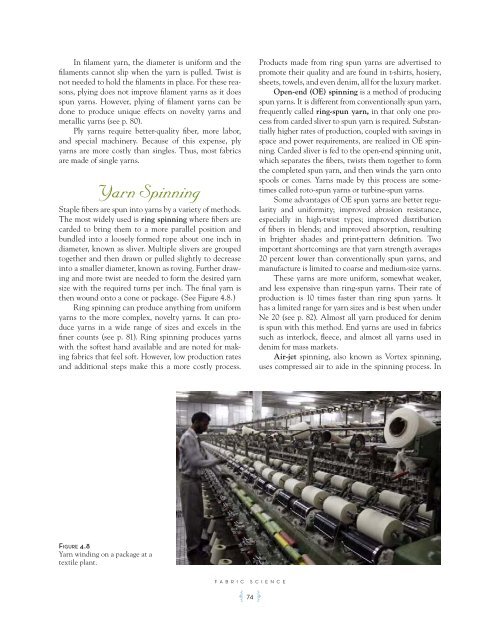Create successful ePaper yourself
Turn your PDF publications into a flip-book with our unique Google optimized e-Paper software.
In filament yarn, the diameter is uniform and the<br />
filaments cannot slip when the yarn is pulled. Twist is<br />
not needed to hold the filaments in place. For these reasons,<br />
plying does not improve filament yarns as it does<br />
spun yarns. However, plying of filament yarns can be<br />
done to produce unique effects on novelty yarns and<br />
metallic yarns (see p. 80).<br />
Ply yarns require better-quality fiber, more labor,<br />
and special machinery. Because of this expense, ply<br />
yarns are more costly than singles. Thus, most fabrics<br />
are made of single yarns.<br />
Yarn Spinning<br />
Staple fibers are spun into yarns by a variety of methods.<br />
The most widely used is ring spinning where fibers are<br />
carded to bring them to a more parallel position and<br />
bundled into a loosely formed rope about one inch in<br />
diameter, known as sliver. Multiple slivers are grouped<br />
together and then drawn or pulled slightly to decrease<br />
into a smaller diameter, known as roving. Further drawing<br />
and more twist are needed to form the desired yarn<br />
size with the required turns per inch. The final yarn is<br />
then wound onto a cone or package. (See Figure 4.8.)<br />
Ring spinning can produce anything from uniform<br />
yarns to the more complex, novelty yarns. It can produce<br />
yarns in a wide range of sizes and excels in the<br />
finer counts (see p. 81). Ring spinning produces yarns<br />
with the softest hand available and are noted for making<br />
fabrics that feel soft. However, low production rates<br />
and additional steps make this a more costly process.<br />
Figure 4.8<br />
Yarn winding on a package at a<br />
textile plant.<br />
FABRIC SCIENCE<br />
A 74 F<br />
Products made from ring spun yarns are advertised to<br />
promote their quality and are found in t-shirts, hosiery,<br />
sheets, towels, and even denim, all for the luxury market.<br />
Open-end (OE) spinning is a method of producing<br />
spun yarns. It is different from conventionally spun yarn,<br />
frequently called ring-spun yarn, in that only one process<br />
from carded sliver to spun yarn is required. Substantially<br />
higher rates of production, coupled with savings in<br />
space and power requirements, are realized in OE spinning.<br />
Carded sliver is fed to the open-end spinning unit,<br />
which separates the fibers, twists them together to form<br />
the completed spun yarn, and then winds the yarn onto<br />
spools or cones. Yarns made by this process are sometimes<br />
called roto-spun yarns or turbine-spun yarns.<br />
Some advantages of OE spun yarns are better regularity<br />
and uniformity; improved abrasion resistance,<br />
especially in high-twist types; improved distribution<br />
of fibers in blends; and improved absorption, resulting<br />
in brighter shades and print-pattern definition. Two<br />
important shortcomings are that yarn strength averages<br />
20 percent lower than conventionally spun yarns, and<br />
manufacture is limited to coarse and medium-size yarns.<br />
These yarns are more uniform, somewhat weaker,<br />
and less expensive than ring-spun yarns. Their rate of<br />
production is 10 times faster than ring spun yarns. It<br />
has a limited range for yarn sizes and is best when under<br />
Ne 20 (see p. 82). Almost all yarn produced for denim<br />
is spun with this method. End yarns are used in fabrics<br />
such as interlock, fleece, and almost all yarns used in<br />
denim for mass markets.<br />
Air-jet spinning, also known as Vortex spinning,<br />
uses compressed air to aide in the spinning process. In













